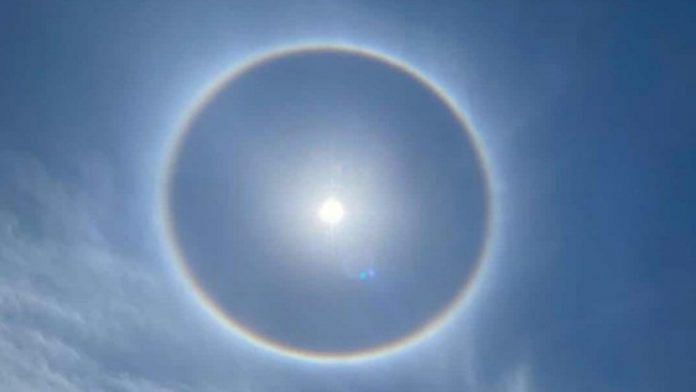Bengaluru: An iridescent halo was spotted around the sun in the skies over Bengaluru, mid-morning Monday. Known as a sun halo, it appears like a circular rainbow around the sun, visible bright during the day.
BANGALORE SUN TODAY? pic.twitter.com/AETlGptSGS
— shreya⁷ (@tetecheekies_) May 24, 2021
Halos around the sun are caused by the refraction or the splitting of sunlight by ice crystals in the atmosphere. Circular halos specifically are produced by cirrus clouds, which are thin, detached, hair like clouds. These clouds are formed very high up in the atmosphere, at a height of over 20,000 feet.
Just like a rainbow, a halo is visible when viewed from the right angle — sometimes appearing just white but often with colours of the spectrum also clearly present.
Such a halo could also occur around the moon at night, which is formed due to the same phenomenon.
Sun Halo in Bangalore ??? pic.twitter.com/KnD5Ne2hhk
— Clement C Jayakumar (@Clementcjayakum) May 24, 2021
Cirrus clouds typically precede rainstorms and sun halos are often followed by rains a few hours later.
Also read: This 16-year-old Star Trek-Star Wars fan from Pune has captured epic, viral image of Moon
22-degree halos
Circular halos around the sun are large, with a typical radius of a human arm, when viewed from the Earth. These halos are also called 22-degree halos, as the halo or ring has an apparent radius of 22 degrees around the sun.
This is measured in the form of angular or apparent distance, where the opposite ends of a line of the halo’s radius is traced back to our line of sight at an angle of 22 degrees.
22 degree Sun Halo! It’s beautiful? #Bangalore pic.twitter.com/EyLcdjqu6S
— Ashwin Deshpande (@trollpwnde) May 24, 2021
A much larger halo with an apparent radius of 46 degrees is also produced, called the 46-degree halo. This is much rarer than the 22-degree halo, which, in turn, is actually more frequent than rainbows in a year.
The exact orientation required for hexagonal ice crystals to cause a 22-degree halo is not fully understood.
However, it is thought that the sun’s rays pass through two faces of a crystal, inclined at 60 degrees to each other. As a result, the light is bent by 22 degrees from its original position.
The halo is the brightest at the inner edge of the circular disk, with no light inside the disk as no light is refracted at smaller angles.
Glorious sun #halo in Bangalore right now. pic.twitter.com/2oTR7Q1PU0
— Kiran Jonnalagadda (@jackerhack) May 24, 2021
Red light is refracted less than other colours of light, so the halo’s inner edge is reddish. Other shades typically tend to overlap and wash out.
However, the exact mechanism behind the orientation of these crystals by the winds and the shape in which they do so are unclear and is the subject of much ongoing research.
Also read: Moon & Mars done, Jupiter & Uranus next on the list — China’s racing away in space too
Other types of halos
There are also other forms a halo could take, such as a sun dog or a parhelion. A sun dog is a bright spot that appears on a halo on one or both sides of the sun. Typically, two sun dogs are spotted on opposite sides of the sun over a 22-degree halo when this phenomenon occurs.
There are also sun pillars where vertical beams of light appear to extend above and below a light source. Light pillars can also be caused by lights from the moon, or more commonly, from street lamps.
There are also other phenomenon like a 9-degree smaller halo, multiple concentric circular halos, a tangent arc which appears tangential to a halo, a parhelia circle which is a horizontal line that appears at the same height as the sun, a circumzenithal arc that looks like an upside down rainbow, or a circumhorizontal arc that looks like a horizontal straight rainbow.
Also read: Moons with masks, sky on Skype — Covid has changed life for Bengaluru astronomers’ club



